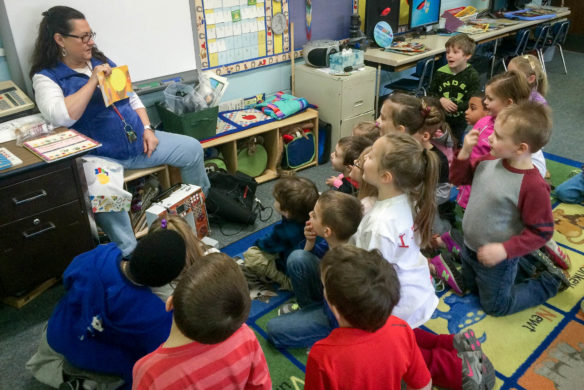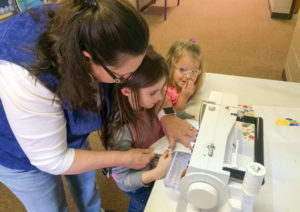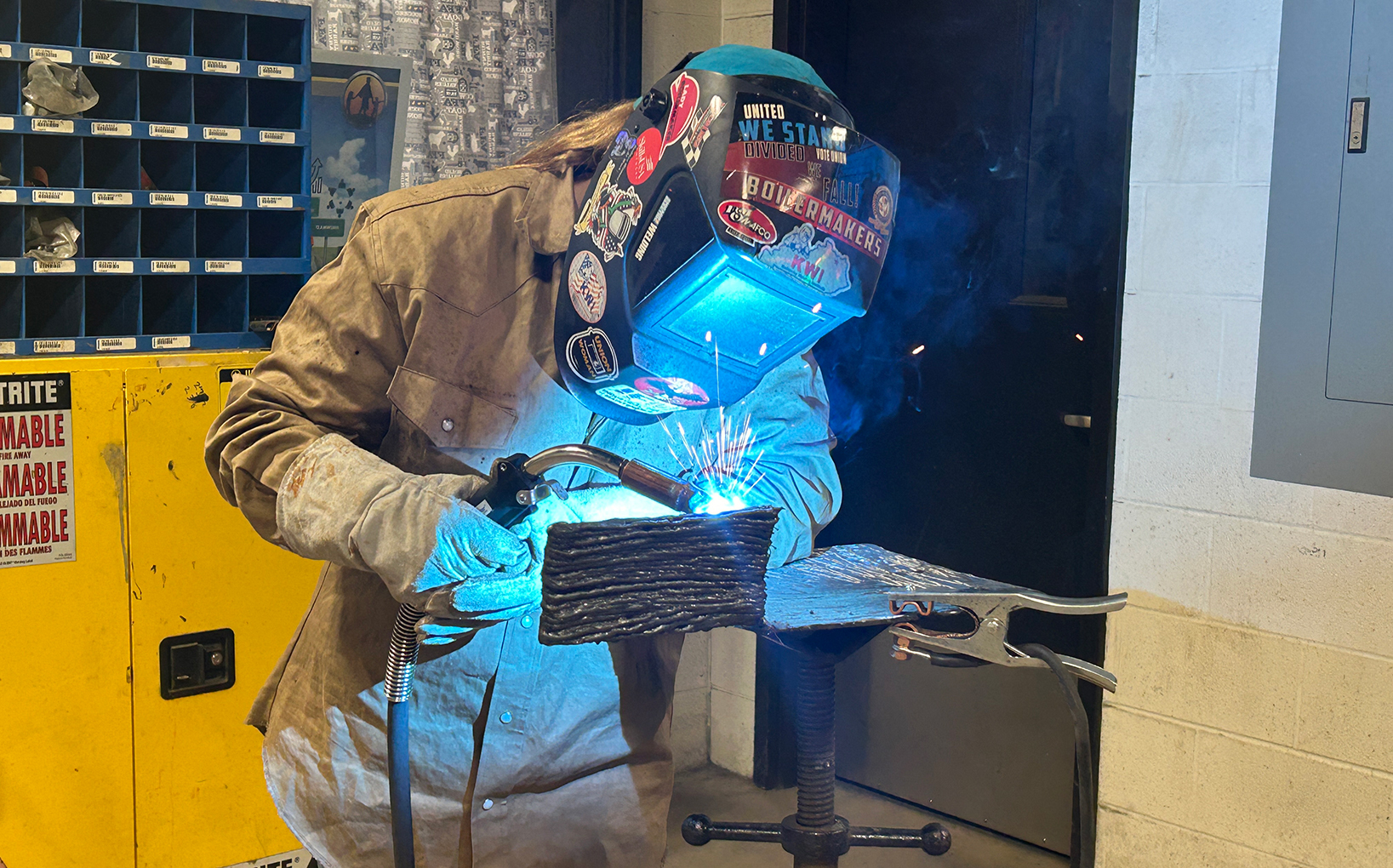
Geri Willis, coordinator of the Ashland Family Resource Center, reviews shapes with students at Hager Elementary in preparation for a math-based quilting project. The center serves Hager and Crabbe elementary schools in the Ashland Independent district.
Photo by Kerri Keener
By Brenna R. Kelly
Brenna.kelly@education.ky.gov
No two days at school are the same for Geri Willis. One day she’s finding hats and gloves for students, the next she’s helping a grandmother navigate the court system to gain guardianship.
Some of her days are spent searching Ashland’s hotels for a student who hasn’t come to school for several days, others are filled with calls to social service agencies to find a student’s family a place to stay.
No task is too big or too small for Willis, coordinator of the Ashland Family Resource Center, which serves two Ashland Independent elementary schools.
“We’ve even gone so far as to buy alarm clocks,” she said. “You do what you can to help your students.”
Kentucky’s system of school-based Family Resource and Youth Service Centers (FRYSCs), was created as part of the Kentucky Education Reform Act of 1990 as a way to remove nonacademic barriers to learning. Now in its 25th year, there are 816 centers across the state serving 626,696 students and their families.
“When we first came on board, it was the whole selling of myself as a coordinator, just begging people to let us be involved,” said Mike Flynn, youth services center coordinator for Estill County Middle School. ”Parents didn’t know what we were, schools didn’t know what we were. We had to break those barriers down.”
But 25 years later the centers are an integral part of most schools, he said.

Geri Willis helps a Hager Elementary student sew a quilt square as part of a math-based quilting project.
Photo by Kerri Keener
“It’s a complete cultural shift. People automatically expect us to be involved with things,” Flynn said. ”They bring issues and problems to us. We are now really ingrained into the schools as a whole.”
Though they are part of schools, FRYSCs are run by the Kentucky Cabinet for Health and Family Services.
Schools in which 20 percent of students qualify for free or reduced-price lunch are eligible for a center. The center is then funded based on the number of students who qualify for free lunch, said Flynn, who is also past president of the Family Resource and Youth Services Coalition of Kentucky a statewide professional organization.
“Even though we are based on the free lunch numbers, we serve every student regardless of financial status,” he said.
Though centers are most known for helping students and their families in difficult situations or supplying food or clothing, that service isn’t required under state law.
Many people don’t realize all the other services the centers provide, which are required under state law– such as referring families and students to mental health and substance abuse counseling, offering career training, summer job placement for high school students and promoting family literacy. The centers also serve as a bridge between school, homes and the community.
In July, coordinators at attended the annual Victory over Violence conference where they received training on helping children from families of substance abuse, bullying prevention and how to involve families in students’ success.
Many centers also provide programs to bolster the learning going on in the classroom. Flynn has worked with teachers to plan math nights for parents. In the summer, many centers provide programming based around the free summer meals program.
“We provide workshops and activities for the kids, so you’re not just getting food but a little be extra instruction,” Flynn said. Several national education groups have recently taken notice of Kentucky’s system of support centers. Doug Jones, manager of FRYSC Region 7 – which covers northeastern Kentucky led a group of 15 educators from six states last fall as they visited Kentucky to see how FRYSCs work. The group, which included representatives from National Education Association, the Center for Popular Democracy and Communities in Schools, visited three centers in eastern Kentucky and two centers in Lexington.
“They are looking at Kentucky as a template for trying to legislate FRYSC-model programs across the United States,” Jones said.
The group brought more educators in December and conducted 35 videotaped interviews with students, teachers, legislators and coordinators.
“We are planning educational and motivational materials, legislative pushes and more,” Evie Frankl, organizer of education justice campaigns for the Center for Popular Democracy said in a release. “We are thankful for the Kentucky program for leading the way for so many years and for generously sharing their knowledge with us.”
The idea of resource centers in schools was new to Kentucky 26 years ago as KERA was being drafted. Some opposed their creation, but Harry J. Cowherd, the secretary of the Cabinet for Human Resources in 1990, championed the creation the FRSYC network.
The annual center of excellence award is now named for Cowherd. In November, Wilis and her center received the award for their work with homeless students.
Willis applied for and received a McKinney-Vento grant, which allowed the elementary schools to hire three home/school liaisons to help families get immunizations, physicals and other screenings and provided tutoring for 43 students living in a domestic violence shelter.
“A lot of our student population is from hotels, motels, shelters and public housing,” she said. ”We also have a lot of kids being raised by relatives.”
In addition to the McKinney-Vento grant, she received a $58,000 grant from BBT Bank for homeless students. Part of the money will pay for a nine-passenger van that will let Willis pick up parents who don’t have transportation so they can attend parent/teacher conferences. It also will be used take homeless high school students to co-op sites. Part of the money will pay those co-op students’ equipment for medical classes, she said.
Willis’ center serves Hager Elementary, where more than half of the students qualify for free or reduced-price lunch, Crabbe Elementary, where all students qualify for free or reduced-priced lunch and a preschool/Headstart program. She works closely with administrators, teachers and staff to make sure she her students’ needs are being met and that teachers know what’s going on with their students.
“This staff is probably the most compassionate group of people I’ve ever met in my life,” she said. “They know and understand the situations that our students come from.”
Crabbe Elementary Principal Jamie Campbell, estimates that about 60 percent of his students will go through some kind of change that requires the resource center’s assistance.
“I am firm believer in the fact we have to make sure that their basic needs are met,” he said. “Because if you’re hungry, if you’re freezing, if you’re worried about safety where you’re going to be at home, if you are worried about that, I cannot teach you reading, writing and math.
“Geri and her team take care of that need for the teachers, it translates into students being able to come here and learn.”
MORE INFO…
Geri Willis Geri.Willis@Ashland.kyschools.us
Jamie Campbell James.Campbell@Ashland.kyschools.us
Mike Flynn Michael.Flynn@Estill.kyschools.us
Doug Jones WDouglas.Jones@ky.gov



Leave A Comment